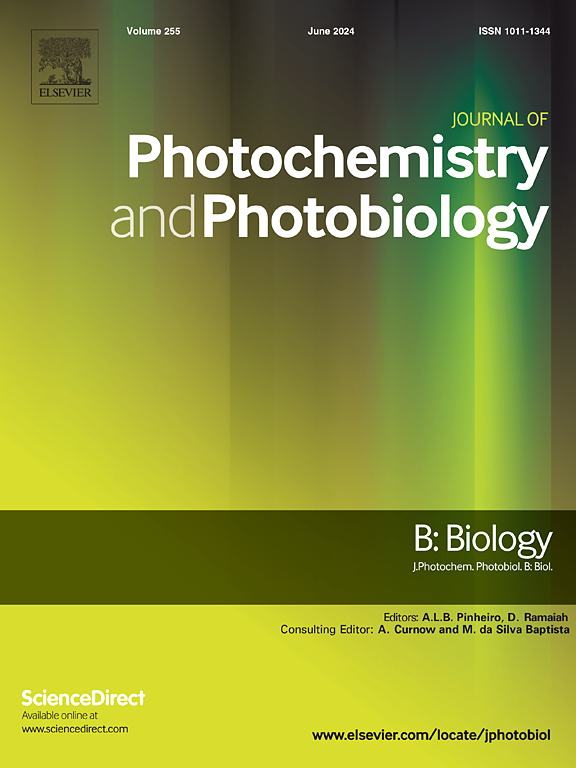Syringic acid protective role: Combatting oxidative stress induced by UVB radiation in L-929 fibroblasts
IF 3.9
2区 生物学
Q2 BIOCHEMISTRY & MOLECULAR BIOLOGY
Journal of photochemistry and photobiology. B, Biology
Pub Date : 2025-01-25
DOI:10.1016/j.jphotobiol.2025.113104
引用次数: 0
Abstract
Neglecting proper skin care and repeated exposure to ultraviolet (UV) radiation can have serious consequences, including skin burns, photoaging and even the development of skin cancer. UV radiation-induced damage is mediated by highly unstable and reactive molecules, named reactive oxygen species (ROS). To counteract ROS, the skin has an endogenous antioxidant system. Considering that, many sunscreens incorporate antioxidant substances to ensure additional photochemioprotective action in the formulation. Syringic acid (SA) is classified as a phenolic acid derived from hydroxybenzoic acid. It has antioxidant properties, which can reduce oxidative stress, and has shown potential to prevent skin cancer. The aim of this study was to assess the ability of SA to protect L-929 fibroblasts from UVB radiation by evaluating oxidative stress biomarkers. As a result, we demonstrated the antioxidant activity of SA through four methodologies, and confirmed the photochemioprotective activity of SA by attenuating the cytotoxicity of UVB radiation in L-929 fibroblasts. The mechanisms involved in the photoprotection of SA include a significant reduction in total ROS, maintenance of mitochondrial membrane potential, decrease in lipid peroxidation, preservation of endogenous antioxidant system enzymes and reduced glutathione (GSH) levels, thereby mitigating the ultrastructural damage caused by UVB. Additionally, SA showed promising results in wound healing. Considering such properties, SA emerges as a strong candidate for incorporation into photoprotective and multifunctional formulations.
丁香酸的保护作用:对抗UVB辐射诱导的L-929成纤维细胞氧化应激。
忽视适当的皮肤护理和反复暴露在紫外线辐射下会导致严重的后果,包括皮肤烧伤、光老化甚至皮肤癌的发展。紫外线辐射引起的损伤是由高度不稳定的活性分子介导的,称为活性氧(ROS)。为了对抗活性氧,皮肤有一个内源性抗氧化系统。考虑到这一点,许多防晒霜都含有抗氧化物质,以确保配方中有额外的光化学保护作用。丁香酸(SA)是一种由羟基苯甲酸衍生而来的酚酸。它具有抗氧化特性,可以减少氧化应激,并显示出预防皮肤癌的潜力。本研究的目的是通过评估氧化应激生物标志物来评估SA保护L-929成纤维细胞免受UVB辐射的能力。因此,我们通过四种方法证明了SA的抗氧化活性,并通过减弱UVB辐射对L-929成纤维细胞的细胞毒性证实了SA的光化学保护活性。SA的光保护机制包括显著减少总ROS,维持线粒体膜电位,减少脂质过氧化,保存内源性抗氧化系统酶和谷胱甘肽(GSH)水平,从而减轻UVB引起的超微结构损伤。此外,SA在伤口愈合方面也有很好的效果。考虑到这些特性,SA成为光防护和多功能配方的强有力的候选者。
本文章由计算机程序翻译,如有差异,请以英文原文为准。
求助全文
约1分钟内获得全文
求助全文
来源期刊
CiteScore
12.10
自引率
1.90%
发文量
161
审稿时长
37 days
期刊介绍:
The Journal of Photochemistry and Photobiology B: Biology provides a forum for the publication of papers relating to the various aspects of photobiology, as well as a means for communication in this multidisciplinary field.
The scope includes:
- Bioluminescence
- Chronobiology
- DNA repair
- Environmental photobiology
- Nanotechnology in photobiology
- Photocarcinogenesis
- Photochemistry of biomolecules
- Photodynamic therapy
- Photomedicine
- Photomorphogenesis
- Photomovement
- Photoreception
- Photosensitization
- Photosynthesis
- Phototechnology
- Spectroscopy of biological systems
- UV and visible radiation effects and vision.

 求助内容:
求助内容: 应助结果提醒方式:
应助结果提醒方式:


